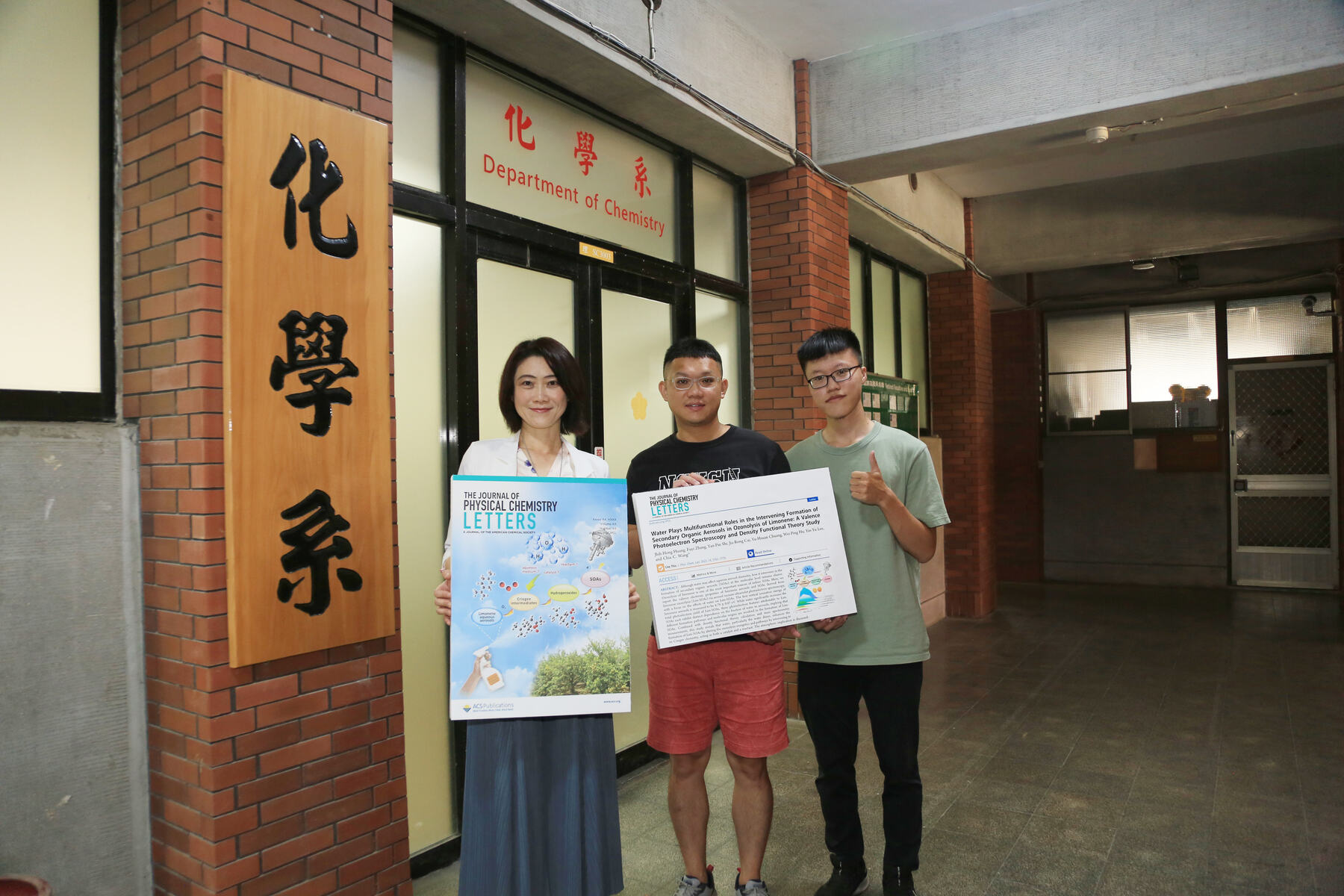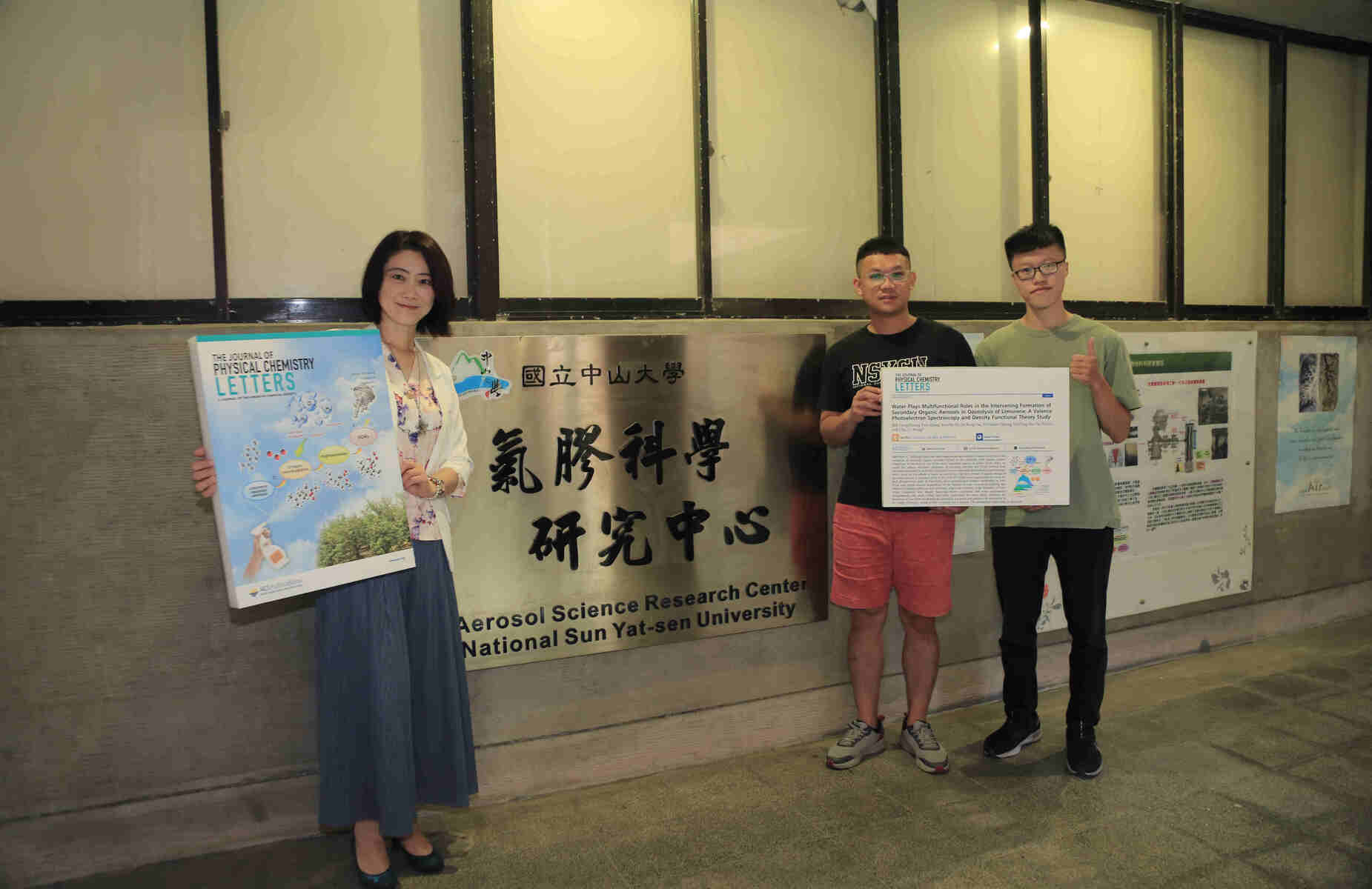Latest study conducted by the NSYSU team reveals water’s multifunctional roles in the ozonolysis of monoterpene to generate PM2.5



2023-11-14
The ground-level ozone generated by air pollution, such as anthropogenic pollutants emitted from industrial or traffic sources, not only causes oxidative damages to living organisms, but also serves as important gaseous precursor for secondary PM2.5. It has become a major issue of concern and interest for scientists worldwide to clarify how ozone intervenes in the formation of SOAs and what are the affecting factors. The research team led by Chia C. Wang, the Associate Professor of the NSYSU Department of Chemistry and Director of the NSYSU Aerosol Science Research Center, recently conducted a study to investigate the secondary PM2.5 derived from limonene ozonolysis via aerosol vacuum ultraviolet photoelectron spectroscopy techniques. They observed that water plays multifunctional and significant roles in affecting the generation of secondary PM2.5 and their thermodynamic characteristics, electronic energetic structure, and formation yields. Besides, the team emphasized that the concentration of ozone in the environment, including both outdoors and indoors, is influential and non-negligible in facilitating the formation of secondary PM2.5, and in causing adverse health effects on living organisms. This study has been published in The Journal of Physical Chemistry Letters, and selected as the inner cover story in the issue.
A variety of volatile organic compounds (VOCs) exists in the environment. Among various VOCs, those unsaturated hydrocarbons with carbon double bonds (C=C) can react readily with atmospheric oxidants to cause a series of chemical reactions, as soon as released into the air, to generate small aerosol particulate matter. A majority of the particulate matter formed during complex chemical reactions are of diameters less than 2.5 microns, thus categorized as secondary PM2.5. These secondary PM2.5 account for 70% to 80% of total suspended particulate matter. The research team focused on investigating limonene, the third most abundant monoterpene in the environment in this study. Limonene can be released from both the natural environment and human daily life, such as household detergents with lemon or orange scents, or essential oils. A previous study reported that the concentration of limonene indoors can be more than two orders of magnitude higher than that found outdoors when limonene-containing products are used indoors. Because limonene has two C=C bonds, limonene and ozone can react easily to generate secondary PM2.5. Ozonolysis of limonene has been considered as the most important source of indoor secondary PM2.5.
“Previous studies have pointed out that exposure to secondary PM2.5 generated from ozonolysis of monoterpene, for example, limonene may cause adverse impacts to human bodies, such as oxidative damage, inflammatory response, lung injury” said Professor Wang. The research team applied the vacuum ultraviolet (VUV) radiation generated by The National Synchrotron Radiation Research Center (NSRRC) as the photoionization source, and utilized aerosol vacuum ultraviolet photoelectron spectroscopy techniques to observe, for the first time, the valence electronic structures of limonene aerosols and the secondary PM2.5 generated during its ozonolysis. Moreover, the team discovered that the more water contained in the limonene aerosols, the more abundant SOAs it generates. In this study, the SOAs yield was increased by a factor of 4.8 when comparing the experiment conditions containing the highest amount of water with that containing no water.
In this study, the research team combined the photoelectron spectroscopy, density functional theory quantum mechanics calculations, and high-resolution liquid chromatography-electrospray ionization, revealing that water directly intervenes in the ozonolysis of limonene and its Criegee chemistry. Water, on one hand, acts as a catalyst by lowering the energy barrier in the formation of hydroperoxide from isomerization of Criegee intermediates. On the other hand, water, especially water dimer, also acts as a reactant to directly react with Criegee intermediate during limonene ozonolysis, thus opening a new pathway for PM2.5 generation. This study also reveals that the chemical composition of PM2.5 generated from ozonolysis of water-containing limonene aerosol differs from that generated from ozonolysis of dry limonene aerosol containing no water.
Water makes up the third most abundant component in the air, after nitrogen and oxygen. It has been conventionally considered solely as polar aqueous medium, instead of a catalyst or reactant. However, mounting studies showed that the importance of water in affecting the atmospheric processes increases in regions with severe air pollution. This issue is both important and non-negligible in Asian countries, where the relative humidity is generally higher than America and European countries. This latest study conducted by the ASRC research team led by Professor Wang reveals, for the first time, the multifunctional roles played by water during the formation of secondary PM2.5 in ozonolysis of monoterpenes. Because the influential effects of water were not taken into consideration in most atmospheric chemical reaction modeling simulation, the overall yield of secondary PM2.5 generated in the reactions where water plays a role may have very likely been underestimated, which in turn contribute to the uncertainty when predicting the impact of aerosols on climate change.
Another substantial point conveyed by this study is the concentration of ozone, including both outdoors and indoors, is a non-negligible factor in affecting the formation of secondary PM2.5 and their further health impact on living organisms. Professor Wang stated that the aerosol vacuum ultraviolet photoelectron spectroscopy used in this study was developed and built by the ASRC team at NSYSU, and is the technique with the highest spectra resolution among the similar techniques around the globe. This technique has been recently adopted by Lawrence Berkeley National Laboratory (LBNL), United States of America (U.S.A.). The first author of this research paper is Jhih-Hong Huang, the doctoral candidate of the Department of Chemistry at NSYSU. The co-authors include Dr. Yin-Yu Lee at National Synchrotron Radiation Research Center (NSRRC) and Processor Wei-Ping Hu of the Department of Chemistry and Biochemistry at National Chung Cheng University (CCU).
For more information, please refer to the journal:
https://doi.org/10.1021/acs.jpclett.3c00560
